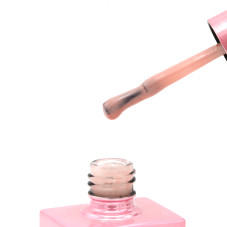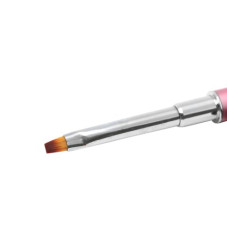Tips or molds? Which is better for nail extensions?

Today, every other modern girl gets her nails done. Not everyone has naturally long nails, which is why nail extensions are a great help. It is known that during nail extension the master can use tips or forms. For sure, everyone is asking themselves the question, and what is better, tips or forms. Many consider that the tips significantly strengthen the natural nails. Others hold the opinion that extensions on the form look more natural. In general, to «taste and colour there is no comrade», so in this article we will try to describe each process individually, but the choice will of course remain up to you.
To begin with, let's give definitions of types and shapes for nail extensions.
WHAT ARE TIPS OR OVERHEAD NAIL EXTENSIONS?
Tips are pre-fabricated plastic extensions of a certain thickness that fit the shape of the nail. They are made of a stable elastic material, which is completely safe for human health. The length can be shaped as you wish. They are designed to imitate the natural nail.
Tips are distinguished:
1. By the contact area, the place where the tip is glued to the nail. The contact area can be large or small, deep or not, and there are tips and without it (non-contact).
2. According to the form - tips can be straight, classic (with a slight bend), curved, tapered, etc. Also they come in different lengths, but usually they are made long enough.
3. Colour - tips come in natural colour, transparent, coloured and with design. French tips are used to create a French manicure. They are usually non-contact and very thin.
WHAT ARE EXTENSION MOULDS?
Molds are devices (templates or stencils) that are placed under the edge of the natural nail. On which the extension material is placed. Depending on the fabrication materials used, the forms are either disposable or reusable. Disposable forms are more convenient because they can be adapted to any nail plate. There are marks on the surface of the mold to indicate the size of the nails, which helps the technician to shape the lengths immediately. (For more information on the nail moulds, see our article «Shapes for nail Extensions. Everything you need to know about them»).
You already know the basics about moulds and tips. Now let's try to explain the best way to build up your nails.
WHEN TO USE TIPS AND WHEN TO USE MOULDS?
What to choose is, of course, the client's desire, but you also have to consider the condition of the nails, so read on and take note.
1. Oval or almond shape. This shape of the nail is considered to be classic and in this case both the first and the second method of nail extension are suitable. The only thing to keep in mind is that the free edge of the nail should extend at least 1-2 millimeters. If the free edge is not present, only tips are suitable.
2. Flat nails. The width of the nail bed: if it is too wide, the shape can be used, but in some cases the width of the shape may not be enough.
3. "Nibbed nails. It is best to extend on tips with a small contact area. The nail planes are always uneven, and the nail sinks in the high fingertips. In this case, the technician will need to file the unevenness thoroughly and create a flat surface for the tips to stick on.
4. Normal nails. If the nails are properly almond-shaped, there's no problem with the choice of fitting and the technician can offer either of the two: tray or tips.
5. Nails are bent downwards. In this case, only the form is suitable. And the form should be selected along the line of the smile under the natural nail.
6. Trapezoidal nails. During the extension of such nails, tips with a small contact area with a pronounced S-curve are used. A classic clip-on nail consists of a small contact area and a pronounced S-curve. Before the extension, the nails must be shortly filed.
During nail extension, always choose the method based not only on the desire but also on the condition of the nails. Then your nails will be beautiful and attractive.
Online nail extension equipment shop Global Fashion offers you professional nail extension and nail design materials.
Read also:
1. Nail primer. What is it for?
2. Top for gel polish. What is it for?
3. Nail base. All its subtleties
4. Manicurist'sbasic set
To begin with, let's give definitions of types and shapes for nail extensions.
WHAT ARE TIPS OR OVERHEAD NAIL EXTENSIONS?
Tips are pre-fabricated plastic extensions of a certain thickness that fit the shape of the nail. They are made of a stable elastic material, which is completely safe for human health. The length can be shaped as you wish. They are designed to imitate the natural nail.
Tips are distinguished:
1. By the contact area, the place where the tip is glued to the nail. The contact area can be large or small, deep or not, and there are tips and without it (non-contact).
2. According to the form - tips can be straight, classic (with a slight bend), curved, tapered, etc. Also they come in different lengths, but usually they are made long enough.
3. Colour - tips come in natural colour, transparent, coloured and with design. French tips are used to create a French manicure. They are usually non-contact and very thin.
WHAT ARE EXTENSION MOULDS?
Molds are devices (templates or stencils) that are placed under the edge of the natural nail. On which the extension material is placed. Depending on the fabrication materials used, the forms are either disposable or reusable. Disposable forms are more convenient because they can be adapted to any nail plate. There are marks on the surface of the mold to indicate the size of the nails, which helps the technician to shape the lengths immediately. (For more information on the nail moulds, see our article «Shapes for nail Extensions. Everything you need to know about them»).
You already know the basics about moulds and tips. Now let's try to explain the best way to build up your nails.
WHEN TO USE TIPS AND WHEN TO USE MOULDS?
What to choose is, of course, the client's desire, but you also have to consider the condition of the nails, so read on and take note.
1. Oval or almond shape. This shape of the nail is considered to be classic and in this case both the first and the second method of nail extension are suitable. The only thing to keep in mind is that the free edge of the nail should extend at least 1-2 millimeters. If the free edge is not present, only tips are suitable.
2. Flat nails. The width of the nail bed: if it is too wide, the shape can be used, but in some cases the width of the shape may not be enough.
3. "Nibbed nails. It is best to extend on tips with a small contact area. The nail planes are always uneven, and the nail sinks in the high fingertips. In this case, the technician will need to file the unevenness thoroughly and create a flat surface for the tips to stick on.
4. Normal nails. If the nails are properly almond-shaped, there's no problem with the choice of fitting and the technician can offer either of the two: tray or tips.
5. Nails are bent downwards. In this case, only the form is suitable. And the form should be selected along the line of the smile under the natural nail.
6. Trapezoidal nails. During the extension of such nails, tips with a small contact area with a pronounced S-curve are used. A classic clip-on nail consists of a small contact area and a pronounced S-curve. Before the extension, the nails must be shortly filed.
During nail extension, always choose the method based not only on the desire but also on the condition of the nails. Then your nails will be beautiful and attractive.
Online nail extension equipment shop Global Fashion offers you professional nail extension and nail design materials.
Read also:
1. Nail primer. What is it for?
2. Top for gel polish. What is it for?
3. Nail base. All its subtleties
4. Manicurist'sbasic set
Published: 28.03.2022 12:17
Times Read: 4423
112 bought
ID: 8102
6,99 £































































